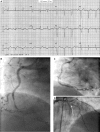Early occlusion of the non-infarct-related coronary artery following successful primary percutaneous coronary intervention in ST-elevation myocardial infarction
- PMID: 26161106
- PMCID: PMC4495130
- DOI: 10.5114/pwki.2015.52287
Early occlusion of the non-infarct-related coronary artery following successful primary percutaneous coronary intervention in ST-elevation myocardial infarction
Abstract
We present a clinical case of early occlusion of the non-infarct-related artery (non-IRA) in a patient with ST-elevation myocardial infarction (STEMI) treated with primary percutaneous coronary intervention (pPCI). Several hours after successful percutaneous treatment of the occluded right coronary artery the patient developed a second myocardial infarction, which was caused by acute occlusion of the left anterior descending artery, which had a significant lesion in the proximal segment. The lesion was diagnosed during the first catheterization, but was left untreated. We discuss the potential advantages and risks associated with the ad-hoc multivessel PCI strategy in STEMI.
Keywords: ST-elevation myocardial infarction; multivessel percutaneous coronary intervention; non-infarct-related artery.
Figures


Similar articles
-
Remote ischemic post-conditioning of the lower limb during primary percutaneous coronary intervention safely reduces enzymatic infarct size in anterior myocardial infarction: a randomized controlled trial.JACC Cardiovasc Interv. 2013 Oct;6(10):1055-63. doi: 10.1016/j.jcin.2013.05.011. JACC Cardiovasc Interv. 2013. PMID: 24156966 Clinical Trial.
-
Efficacy and Safety of a Pharmaco-Invasive Strategy With Half-Dose Alteplase Versus Primary Angioplasty in ST-Segment-Elevation Myocardial Infarction: EARLY-MYO Trial (Early Routine Catheterization After Alteplase Fibrinolysis Versus Primary PCI in Acute ST-Segment-Elevation Myocardial Infarction).Circulation. 2017 Oct 17;136(16):1462-1473. doi: 10.1161/CIRCULATIONAHA.117.030582. Epub 2017 Aug 27. Circulation. 2017. PMID: 28844990 Clinical Trial.
-
Current recommendations for revascularization of non-infarct-related artery in patients presenting with ST-segment elevation myocardial infarction and multivessel disease.Front Cardiovasc Med. 2022 Aug 11;9:969060. doi: 10.3389/fcvm.2022.969060. eCollection 2022. Front Cardiovasc Med. 2022. PMID: 36035910 Free PMC article. Review.
-
Percutaneous Intervention for Concurrent Chronic Total Occlusions in Patients With STEMI: The EXPLORE Trial.J Am Coll Cardiol. 2016 Oct 11;68(15):1622-1632. doi: 10.1016/j.jacc.2016.07.744. J Am Coll Cardiol. 2016. PMID: 27712774 Clinical Trial.
-
Management of Multivessel Coronary Disease in ST-segment Elevation Myocardial Infarction.Curr Cardiol Rep. 2015 Sep;17(9):632. doi: 10.1007/s11886-015-0632-6. Curr Cardiol Rep. 2015. PMID: 26238745 Free PMC article. Review.
Cited by
-
Evaluation of safety and efficacy of elective PCI in patients with cardiac insufficiency.Exp Ther Med. 2017 Feb;13(2):609-613. doi: 10.3892/etm.2016.4005. Epub 2016 Dec 27. Exp Ther Med. 2017. PMID: 28352338 Free PMC article.
-
Complete Revascularization Versus Treatment of the Culprit Artery Only in ST Elevation Myocardial Infarction: A Multicenter Registry.Arq Bras Cardiol. 2020 Aug 28;115(2):229-237. doi: 10.36660/abc.20180346. Arq Bras Cardiol. 2020. PMID: 32876190 Free PMC article. English, Portuguese.
-
A Comparison Between Culprit Versus Complete Revascularization in Diabetic Patients With Acute Myocardial Infarction.Clin Cardiol. 2024 Nov;47(11):e70046. doi: 10.1002/clc.70046. Clin Cardiol. 2024. PMID: 39540303 Free PMC article.
References
-
- Goldstein JA, Demetriou D, Grines CL, et al. Multiple complex coronary plaques in patients with acute myocardial infarction. N Engl J Med. 2000;343:915–22. - PubMed
-
- Sorajja P, Gersh BJ, Cox DA, et al. Impact of multivessel disease on reperfusion success and clinical outcomes in patients undergoing primary percutaneous coronary intervention for acute myocardial infarction. Eur Heart J. 2007;28:1709–16. - PubMed
-
- Steg PG, James SK, Atar D, et al. ESC Guidelines for the management of acute myocardial infarction in patients presenting with ST-segment elevation. Eur Heart J. 2012;33:2569–619. - PubMed
-
- Kornowski R, Mehran R, Dangas G, et al. Prognostic impact of staged versus “one-time” multivessel percutaneous intervention in acute myocardial infarction. Analysis from the HORIZONS-AMI (Harmonizing Outcomes With Revascularization and Stents in Acute Myocardial Infarction) trial. J Am Coll Cardiol. 2011;58:704–11. - PubMed
-
- Manari A, Varani E, Guastaroba P, et al. Long-term outcome in patients with ST segment elevation myocardial infarction and multivessel disease treated with culprit-only, immediate, or staged multivessel percutaneous revascularization strategies: insights from the REAL registry. Catheter Cardiovasc Interv. 2014;84:912–22. - PubMed
Publication types
LinkOut - more resources
Full Text Sources
Other Literature Sources
Miscellaneous
